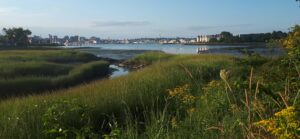Understanding and forecasting the effects of land-sea connections on harmful algal bloom transport in estuaries
Institution: University of Maine
Sponsor: Water Resources Research Institute National Competitive Grants Program (104g)

Project Summary
Shellfish are filter feeders that pump water through their bodies and consume algae they have flltered from the water, some of which can be toxic to humans. The biotoxins found in some algae can accumulate in shellfish, and humans can become sick when they ingest the shellfish meat. The algae reproduce (or “bloom”) when environmental conditions are favorable, creating a Harmful Algal Bloom (HAB) event.
The toxic diatom Pseudo-nitzschia is an algae species that produces a biotoxin that causes Amnesic Shellfish Poisoning (ASP), with human health effects that can include short-term memory loss, gastrointestinal problems, and even fatality.
ASP has been a documented problem on the U.S. Pacific coast for over a decade, but the first ASP event in the Northeast occurred only recently, in 2016. At the same time there has been unprecedented warming in the Gulf of Maine, where sea surface temperature is increasing faster than in 99% of global oceans and seas. There is not enough historical evidence to make conclusions about specific environmental conditions driving and transporting Pseudo-nitzschia in coastal and estuarine waters of the Gulf of Maine. This makes it difficult for decision-makers to predict bloom events and employ responsive monitoring and management strategies.
Solutions to ASP problems require increased knowledge and understanding of the environmental conditions coinciding with HABs, as well as HAB dynamics. These are gaps that this project targets. The project team’s approach will focus on the conditions that drive HAB events by analyzing historical data and performing coupled computer simulations to evaluate how water quality, current velocity, wind, freshwater flows from land areas, and tide conditions influence the frequency and magnitude of ASP events in Maine estuaries. The collection of hydrologic and water quality measurements in study areas of Blue Hill and Frenchman Bays will be an important part of this work to document environmental conditions and accurately simulate them, to advance the capacity to predict when and where events may occur.
An important outcome of this work will be a publicly available online forecasting tool that will run continuously updated simulations to provide a “hindcast” showing past conditions through a 2-3 day forecast of future coastal currents. This will be combined with particle tracking around Blue Hill and Frenchman Bays. The forecasting tool will be collaboratively designed with stakeholders e.g., Maine Department of Marine Resources (DMR), Acadia Aquafarms, National Park Service, Waukeag Neck Oyster Farm, to provide information most appropriate to their ASP monitoring and management strategies. This research will provide new solutions for prediction of problematic ASP events and more accurate delineations of the locations and duration of related shellfish-harvesting closures by decision-makers.
Project Update
The project goal is to relate harmful algal bloom events to estuary circulation patterns and water quality. This will improve understanding of the conditions coinciding with harmful algae bloom events in the region. The team is also developing a forecasting tool to support coastal management decisions in response to the algae bloom events. For the second year of the project, the team focused on three main tasks in the study area of Frenchman Bay, Maine. The first is carrying out the second year of a 16 week field sampling campaign. The second involves numerical modeling of coastal circulation under varied scenarios. And the third is developing an online forecasting tool. Results quantify runoff into coastal estuaries over a range of daily rainfall depths and in the summer and fall months of 2016 and 2021. Outcomes show how coastline characteristics influence circulation patterns that govern movements of harmful algae blooms in estuaries. The team investigated how years with below-average rainfall compare with the presence of harmful algae. Low rainfall depths increase estuary salt content, which is conducive to harmful algae production. Work has been initiated to automate a two day forecast of particle motion in Frenchman Bay. The team also automated visualization of the model output on the research group’s website. Next steps include finalizing model validation and particle placement with stakeholder engagement.
Research Team:
- Team Leader: Lauren Ross, Department of Civil and Environmental Engineering, UMaine
- Sean Smith, School of Earth and Climate Sciences, UMaine
- Sean Birkel, Climate Change Institute, UMaine
- Kohl Kanwit, Maine Department of Marine Resources
- Taylor Bailey, doctoral student, Department of Civil and Environmental Engineering, UMaine
Project Partners:
- Kate Hubbard, Florida Fish and Wildlife, Woods Hole
- Gary Shenk, U.S. Geological Survey, Chesapeake Bay Program
- Thomas Huntington, U.S. Geological Survey, Maine
- Charles Culbertson, U.S. Geological Survey, Maine
Updates, News, and Related Resources:
- UMaine Researchers develop models to forecast lethal ASP toxin movement in waterways, UMaine News (October 22, 2020)
Products
- Webpage – Stream flows into Frenchman Bay
- Presentation – Bailey, Taylor. Linking Hydrodynamics to Harmful Algal Blooms on the Coast of Maine. University of Maine, Networking Session for Sustainability Solutions. April 2022
- Presentation – Bailey, Taylor. Linking Hydrodynamics to Harmful Algal Blooms on the Coast of Maine. Augusta Civic Center, 2022 Maine Sustainability and Water Conference. March 2022
- Presentation – Smith, Sean; Ross, Lauren; Van Dam, Bea. Land-sea Connections of Coastal Places, People, and Science in Maine. University of Maine, Networking Session for Sustainability Solutions. April 2022
- Presentation – Smith, Sean; Ross, Lauren; Van Dam, Bea. Land-sea Connections of Coastal Places, People, and Science in Maine. Augusta Civic Center, 2022 Maine Sustainability and Water Conference. March 2022
- Presentation – Huntington, Thomas. UMaine research to better understand how hydrodynamic forcing and physical conditions influence Pseudo-nitzschia transport in Frenchman Bay. Acadia National Park Intertidal Symposium (virtual)
- Presentation – Ross, Lauren. UMaine research on monitoring and modeling in Frenchman Bay to understand material transport. Invited Speaker, Acadia Science Symposium
